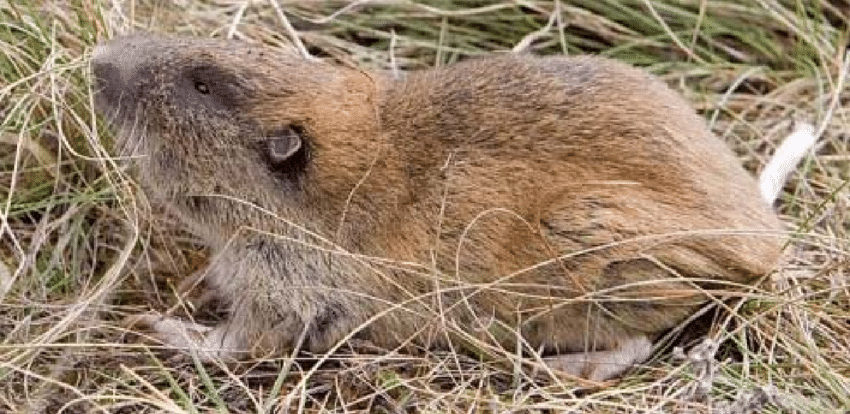Low-
Moderate
In Washington, the Mazama pocket gopher is only found west of the Cascades -- in Thurston, Pierce, Mason, and Clallam counties.
Four subspecies are listed as federally threatened (Roy Prairie, Olympia, Tenino, and Yelm); all subspecies are state threatened. Some subspecies are threatened by habitat loss from human development. Species existence is compatible with some levels of development, but high-density development likely leads to extirpation.
Description and Range
Physical description
The Mazama pocket gopher is one of the smallest of 35 species in the pocket gopher genus Thomomys. It ranges from 7 to 10 inches in length. It has reddish-brown fur with gray undersides. It has prominent incisors, large front claws, and cheek pouches (“pockets”). It differs from the similar-sized northern pocket gopher (Thomomys talpoides) of eastern Washington in fur color, tooth and skeletal characteristics, and a more conspicuous dark patch of fur behind their ears.
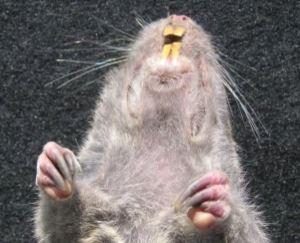
They are frequently confused with moles, but moles do not have prominent teeth, and the soil mounds that they leave behind are dome-shaped while the mounds left by gophers are often lower and more irregular or fan-shaped.
Ecology and life history
Pocket gophers are the only truly subterranean rodents in North America and are rarely observed above-ground, spending most of their time within their system of burrows. This species occurs in grasslands, including glacial outwash prairies, pastures, subalpine meadows, and occasionally clearcuts or Christmas tree farms. Requires well-drained soil for burrowing and appears to be most abundant in loamy sand soil types. It is absent from areas with clay soil or seasonal flooding.
Mazama pocket gophers are herbivores that require grasses and forbs for food. They eat a wide variety of roots and above-ground plant parts. Perennial forbs are preferred over grasses, and fleshy roots and bulbs, such as camas (Camasia spp.) are important when green vegetation is not available. Gophers also eat fungi and disseminate the spores of species that have an important role in facilitating plant growth.
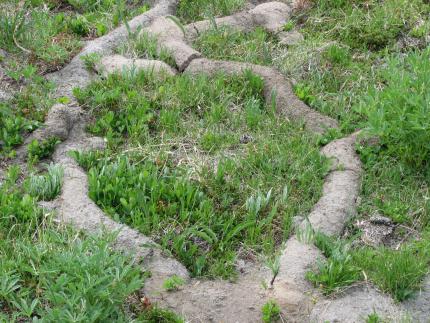
They are generally territorial and solitary outside the reproductive season.
Mazama pocket gophers produce one litter per year, with an average litter size of five young. After weaning, female offspring often establish a burrow system nearby, but male offspring disperse.
Burrows include foraging tunnels and chambers for nesting and caching of food.
Though territorial, burrow systems are often aggregated in favorable habitat. Pocket gophers are ecologically important as prey items and in influencing soils and plant species diversity, and their burrows are a retreat for amphibians, reptiles, and many invertebrates.
Pocket gopher predators include owls, coyotes, and bobcats.
Geographic range
Mazama pocket gophers occur in grasslands in Thurston, Pierce, and Mason Counties, and on a few alpine meadows in Olympic National Park. Washington has six described subspecies; three occur in Thurston County; and Pierce County, Mason County, and the Olympic Mountains each contain different subspecies. Two other subspecies, one near Tacoma and one in Wahkiakum County, appear to be extinct.
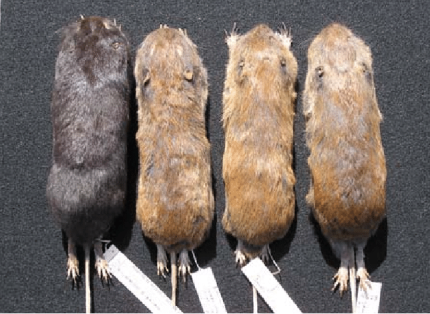
Historically, the species was more widespread on south Puget Sound prairies, but was reduced by habitat loss caused by development, agriculture, and succession or planting of trees and shrubs.
Population sizes for the different subspecies are unknown, but trends are declining for those in Thurston and Pierce Counties.
Other subspecies of Mazama pocket gopher occur in western Oregon and northern California.
For a map of this species' distribution and other information, check out the International Union for Conservation of Nature Red List.
Climate vulnerability
Sensitivity to climate change
Low-
Moderate
Little information exists on the sensitivity of Mazama pocket gophers to climate change. Among subspecies inhabiting prairie environments, some sensitivity may exist to warmer, drier soil conditions during summer that make burrowing more difficult. Sensitivity may also be increased if invasive species such as Scotch broom become more numerous under future climate conditions. However, drier summer weather and possibly increased fire occurrence could benefit prairie and grassland habitats by preventing encroachment of Douglas-fir and woody shrubs, potentially benefiting gophers.
Potential climate change impacts are much different for the Olympic Mountains subspecies, which inhabits small alpine meadows. These gophers are vulnerable to forest encroachment due to warmer temperatures and reduced snowpack, although increases in forest fires resulting from projected increased summer drying may benefit subalpine meadows by preventing conifer encroachment. This subspecies could also be vulnerable to increased predation by coyotes, which appear to be expanding to higher elevations in the Olympics in part because of warmer winters and lower snowpack.
Exposure to climate change
Moderate
- Increased temperatures
- Reduced soil moisture
- Reduced snowpack
- Increased invasive species
- Altered fire regimes
Regulations
Rules and seasons
The Mazama (Western) pocket gopher (Thomomys mazama) of Thurston, Pierce, Clark, and Mason Counties is state threatened and the subspecies in Thurston and Pierce counties were listed as Threatened under the U.S. Endangered Species Act in April 2014. Because only remnant populations of these subspecies and species exist, people are not permitted to use lethal control in these areas. Before moving forward with any type of control in these areas, contact your local state Fish and Wildlife office.
Conservation
Conservation Threats and Actions Needed
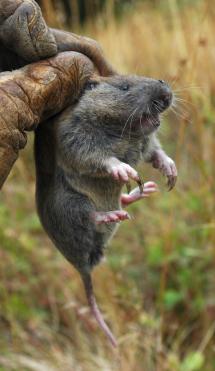
- Fish and wildlife habitat loss or degradation
- Threat: Loss and fragmentation of prairie/grassland habitat.
- Action Needed: Acquire lands and easements in strategic locations and restore habitat.
- Threat: Degradation of prairie/grassland habitat.
- Action Needed: Remove invasive trees and Scot’s broom from prairie/grassland areas.
- Overharvesting of biological resources
- Threat: Trapping by landowners and mortality by pets.
- Action Needed: Inform local residents of gopher trapping restrictions. Promote non-lethal methods of damage control.
- Resource information collection needs
- Threat: Genetic and demographic effects of small population size and catastrophic events
- Action Needed: Determine status and conduct surveys to monitor presence and relative abundance.
See the Climate vulnerability section for information about the threats posed by climate change to this species.
Resources
References
Stinson, D. W. 2013. Draft Mazama pocket gopher status update and Washington state recovery plan. Washington Department of Fish and Wildlife, Olympia, Washington.
WDFW publications
Status reports/Recovery plans
- Mazama Pocket Gopher Status Update and Recovery Plan (2020)
- Washington State Status Report for the Mazama Pocket Gopher, Streaked Horned Lark, and Taylor's Checkerspot (2005)
